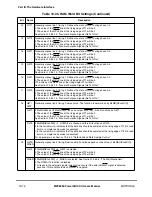
10-66
MPC8260 PowerQUICC II UserÕs Manual
MOTOROLA
Part III. The Hardware Interface
All local bus refreshes are done using the refresh pattern of UPMB. This means that if
refresh is required on the local bus, UPMB must be assigned to the local bus and
MBMR[RFEN] must be set. It also means that only one refresh routine should be
programmed for the local bus, and be placed in UPMB, which serves as the local bus refresh
executor. If refresh is not required on the local bus, UPMB can be assigned to any bus.
UPMC can be assigned to any bus; there is no need to program its refresh routine because
it will use the one in UPMA or UPMB, according to the bus to which it is assigned.
Figure 10-57. Memory Refresh Timer Request Block Diagram
10.6.1.3 Software RequestsÑ
RUN
Command
Software can start a request to the UPM by issuing a
RUN
command to the UPM. Some
memory devices have their own signal handshaking protocol to put them into special
modes, such as self-refresh mode. Other memory devices require special commands to be
issued on their control signals, such as for SDRAM initialization.
For these special cycles, the user creates a special RAM pattern that can be stored in any
unused areas in the UPM RAM. Then the
RUN
command is used to run the cycle. The UPM
runs the pattern beginning at the speciÞed RAM location until it encounters a RAM word
with its LAST bit set. The
RUN
command is issued by setting M
x
MR[OP] = 11 and
accessing the UPMx memory region with a single-byte transaction.
Note that the pattern must contain exactly one assertion of PSDVAL (UTA bit in the RAM
word, described in Table 10-35), otherwise bus timeout may occur.
10.6.1.4 Exception Requests
When the MPC8260 under UPM control initiates an access to a memory device, the
external device may assert TEA or SRESET. The UPM provides a mechanism by which
memory control signals can meet the timing requirements of the device without losing data.
The mechanism is the exception pattern that deÞnes how the UPM deasserts its signals in
a controlled manner.
10.6.2 Programming the UPMs
The UPM is a microsequencer that requires microinstructions or RAM words to generate
signal timings for different memory cycles. Follow these steps to program the UPMs:
1. Set up BR
x
and OR
x
.
2. Write patterns into the RAM array.
60x bus assigned UPM
Local bus assigned UPM
System
Divide by PURT
PTP Prescaling
Divide by LURT
refresh timer request
refresh timer request
Clock
Summary of Contents for MPC8260 PowerQUICC II
Page 1: ...MPC8260UM D 4 1999 Rev 0 MPC8260 PowerQUICC II UserÕs Manual ª ª ...
Page 66: ...lxvi MPC8260 PowerQUICC II UserÕs Manual MOTOROLA ...
Page 88: ...1 18 MPC8260 PowerQUICC II UserÕs Manual MOTOROLA Part I Overview ...
Page 120: ...2 32 MPC8260 PowerQUICC II UserÕs Manual MOTOROLA Part I Overview ...
Page 138: ...Part II iv MPC8260 PowerQUICC II UserÕs Manual MOTOROLA Part II Configuration and Reset ...
Page 184: ...4 46 MPC8260 PowerQUICC II UserÕs Manual MOTOROLA Part II ConÞguration and Reset ...
Page 202: ...Part III vi MPC8260 PowerQUICC II UserÕs Manual MOTOROLA Part III The Hardware Interface ...
Page 266: ...8 34 MPC8260 PowerQUICC II UserÕs Manual MOTOROLA Part III The Hardware Interface ...
Page 382: ...10 106 MPC8260 PowerQUICC II UserÕs Manual MOTOROLA Part III The Hardware Interface ...
Page 392: ...11 10 MPC8260 PowerQUICC II UserÕs Manual MOTOROLA Part III The Hardware Interface ...
Page 430: ...Part IV viii MOTOROLA Part IV Communications Processor Module ...
Page 490: ...14 36 MPC8260 PowerQUICC II UserÕs Manual MOTOROLA Part IV Communications Processor Module ...
Page 524: ...17 10 MPC8260 PowerQUICC II UserÕs Manual MOTOROLA Part IV Communications Processor Module ...
Page 556: ...18 32 MPC8260 PowerQUICC II UserÕs Manual MOTOROLA Part IV Communications Processor Module ...
Page 584: ...19 28 MPC8260 PowerQUICC II UserÕs Manual MOTOROLA Part IV Communications Processor Module ...
Page 632: ...21 24 MPC8260 PowerQUICC II UserÕs Manual MOTOROLA Part IV Communications Processor Module ...
Page 652: ...22 20 MPC8260 PowerQUICC II UserÕs Manual MOTOROLA Part IV Communications Processor Module ...
Page 668: ...23 16 MPC8260 PowerQUICC II UserÕs Manual MOTOROLA Part IV Communications Processor Module ...
Page 758: ...27 28 MPC8260 PowerQUICC II UserÕs Manual MOTOROLA Part IV Communications Processor Module ...
Page 780: ...28 22 MPC8260 PowerQUICC II UserÕs Manual MOTOROLA Part IV Communications Processor Module ...
Page 874: ...29 94 MPC8260 PowerQUICC II UserÕs Manual MOTOROLA Part IV Communications Processor Module ...
Page 920: ...31 18 MPC8260 PowerQUICC II UserÕs Manual MOTOROLA Part IV Communications Processor Module ...
Page 980: ...A 4 MPC8260 PowerQUICC II UserÕs Manual MOTOROLA Appendixes ...
Page 1002: ...Index 22 MPC8260 PowerQUICC II UserÕs Manual MOTOROLA INDEX ...
Page 1006: ......
















































